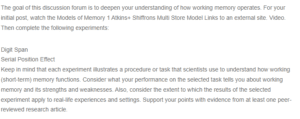Memory Functions
One of the mysteries present when it comes to the brain is the recall limit. Questions like when and how the recall limit occurs always arise, and several theories have been proposed to explain it. One of these theories is the memory-working model, which suggests that working memory is a multi-component framework that manipulates information storage for use by other complex cognitive uses. This multi-component framework includes problem-solving, planning, and language comprehension (Cowan 2010). After taking the experiments, the results showed a fairly good performance, which could have been improved with more practice. Besides, the whole experience was enjoyable and helped me realize how my memory works and how much practice I need to improve it. Further, according to Riegler & Riegler (2012), rehearsal in the working memory helps one transform short-term memory into long-term memory. Therefore, repetition is key in the long-term storage of information.
According to Cowan (2010), memory has a limited storage capacity, ranging from three to five chunks of information. This limitation could be a weakness in that the brain cannot process information in large chunks, as it means that patterns will be too close to each other to be processed separately, or the information will take too long to be processed. Contrastingly, the limited storage capacity could be a strength in that mathematical simulation argues that to search through information efficiently, the groups to be searched need to be approximately 3.5 items on average (Cowan & Rouder, 2009). A list of five is the recommended maximum, as more items will cause confusion and distraction.
The digital span experiment is significant for daily activities as the brain needs to retain a lot of information it is fed daily (Jahanshahi et al., 2008). For example, when we meet new people regularly, we have to remember their names; otherwise, it would be rude if they keep introducing themselves every time we meet. The same case applies to important information like phone numbers of loved ones and personal information like social security numbers and emergency numbers, among others. The second experiment helped me learn about the serial position effect, which shed more light on how my brain works. The serial position effect is an effect attributed to the cognitive biases of the human brain, which include the recency effect and the primary effect (Desai, 2016; Jessica, 2016). I have always tended to forget the things mentioned in the middle of the list and instead remember the first and last ones only, for example, when memorizing a grocery list. Accordingly, I have formed a habit of writing down stuff for a list of more than six items; otherwise, if I am to memorize them, I forget some.
References
Cowan, N. (2010). The magical mystery four: How is working memory capacity limited, and why? Current directions in psychological science, 19(1), 51-57.
Cowan, N., & Rouder, J. N. (2009). Comment on “Dynamic Shifts of Limited Working Memory Resources in Human Vision.” Science, 323(5916), 877-877.
Desai, D. (2016). The significance of the mode of presentation on the serial position effect: an exploratory study. Indian Journal of Mental Health, 3(3).
Jahanshahi, M., Saleem, T., Ho, A. K., Fuller, R., & Dirnberger, G. (2008). A preliminary investigation of the running digit span as a test of working memory. Behavioral neurology, 20(1-2), 17-25.
Jessica, L. (2016). Models of Memory 1 Atkins+ Shiffrons Multi Store Model. YouTube. Accessed from: https://www.youtube.com/watch?v=0A1e_0rl6KU&list=RD0A1e_0rl6KU#t=41
Riegler, B. R., & Riegler, G. R. (2012). Cognitive psychology: Applying the science of the mind. E: Cognitive Psychology An Introduction: ISBN-10, 205033644.
ORDER A PLAGIARISM-FREE PAPER HERE
We’ll write everything from scratch
Question
The goal of this discussion forum is to deepen your understanding of how working memory operates. For your initial post, watch the Models of Memory 1 Atkins+ Shiffrons Multi Store Model Links to an external site. Video. Then complete the following experiments:

Memory Functions
Digit Span
Serial Position Effect
Keep in mind that each experiment illustrates a procedure or task that scientists use to understand how working (short-term) memory functions. Consider what your performance on the selected task tells you about working memory and its strengths and weaknesses. Also, consider the extent to which the results of the selected experiment apply to real-life experiences and settings. Support your points with evidence from at least one peer-reviewed research article.

